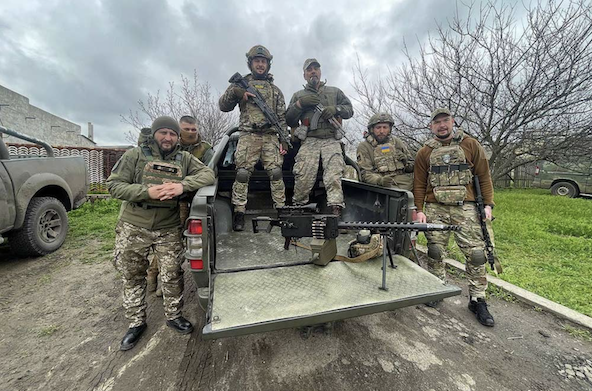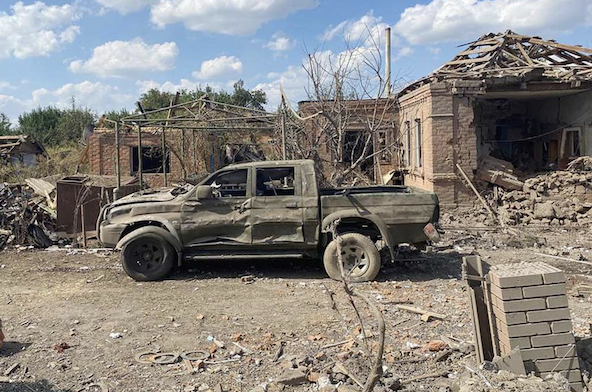The summer of 2023 fell short of expectations for a triumphant Ukrainian counteroffensive and the swift liberation of Ukraine’s occupied territories. Notably absent was the widely anticipated mass bathing of Ukrainians on the southern coast of Crimea, as announced by some government officials. Unfortunately, breaking through the occupiers’ defences proved far more challenging than anticipated. While some prepared swimwear for leisure in Yalta, the enemy was busy constructing formidable defensive fortifications. Much has been written and will continue to be about why this occurred. This entire situation calls for careful analysis and reflection, with testimonies from direct participants in the events being particularly valuable—they are worth their weight in gold.
Hopes for a swift counteroffensive by the Ukrainian Armed Forces in the south were shattered by enemy minefields, according to Skif, deputy commander of the 3rd Separate Battalion “Volyn” of the Ukrainian Volunteer Army (UVA). “The density of mines here was staggering; it was like a nightmare,” he recalls. “There were so many, of various types.” This made it impossible for vehicles to manoeuvre into battle formation. Even if sappers cleared narrow passages or isolated roads, they quickly became traps. “The Russians had us in their sights, and that was it; the vehicles couldn’t advance,” the fighter explains. “Heavy artillery, guided missiles, and endless ATGMs—they had plenty, and they used them effectively. Plus, there were numerous FPV drones. FPV drones took out quite a bit of equipment.”
Clearing the area for an advance so the vehicles could move in formation would take months of demining, in theory. Initially, they used special German Wisent machines for demining, but they were destroyed instantly. “They’re big, sluggish, and lack manoeuvrability. You can spot them from a mile away, making them prime targets,” Skif explains. “They were under constant attack from artillery, ATGMs, and mines,” he adds. “We had to trek about five kilometres to reach our position because we couldn’t get any closer. Along the way, we passed a stretch where many of these robust Wisent machines were parked.”
As summer drew to a close, sappers were painstakingly clearing mines by hand. They crawled through the darkness, methodically working to create safe paths. But their efforts had limitations; they couldn’t simply sweep through and clear the entire field at once. As time passed, the trails they created became increasingly visible from above, drawing the Russians’ attention. “Day after day, more and more people, not just our own, know about these trails,” explains Skif. “Now, when a group of 50 men walks along them, nearly half have to drop to the ground before reaching their destination. The crux of the counteroffensive lies in this very issue—we couldn’t advance across a broad front. Having the aviation support we requested would have made a significant difference. Cutting off their supply lines would have made it much easier to advance and clear mines without the constant threat of resupply or guided missiles.”

Photo: Roman Malko
In the outskirts of Orikhove, facing the Zaporizhzhia direction, the UVA fighters began their operations in the early summer of 2023. Their primary mission was to bolster the assault efforts of the 47th Brigade, serving as a fire support unit. Their arsenal included heavy machine guns, mortars, RPGs, and AGS. However, their duties extended beyond weaponry—they erected gun mounts, provided infantry support, and conducted reconnaissance missions, often venturing across the front lines on foot, reminiscent of the drone era.
Before that, the guys were primarily stationed in the Donetsk region, specifically in the vicinity of Velyka Novosilka, where the Ukrainian Armed Forces initially breached the southern front in spring 2023. “The atmosphere there was more stable, less intense,” explains Skif. “We would go out, do our job, and head back. Here in Orikhove, it’s more vibrant and intense. Well, maybe a tad more nerve-wracking, too, with the heavier and more frequent incoming fire. There’s always something happening,” the soldier jests. “You step out into the field, and suddenly you’re under fire from all directions. It’s hard not to feel a bit stirred up.”
Simply shooting and retreating wasn’t feasible in the Zaporizhzhia region. We had to keep rotating positions, which meant enduring continuous enemy fire. And the positions weren’t too distant, only about 800 meters from the enemy. That’s just how it goes. Every weapon has its effective range, and you need to get within that range, preferably with some extra distance. Because when the assault teams enter a settlement and start clearing the first street, you need to provide cover for at least half the village. And as they advance, you need to adjust your position and keep firing ahead.
“Interestingly,” Skif notes, “if you’re targeted by artillery, the best move is to move towards it, not away. Artillery doesn’t fire from miles away. When an 82mm mortar starts firing, you know its maximum range is 3 – 3.5 km. So, you advance, and it will fire behind you. Typically, nobody shoots at the minimum distance. They take the maximum and leave themselves room to adjust. There’s no need to bring the weapon closer, especially a big one. They position it as far away as possible for protection. And the Russians do the same. They’re not any less clever than us, I reckon. And I know they’re not.”
Skif has been in the thick of war for about two years now. Before that, he had no military background or combat experience. He learned everything on the job from his comrades, who have been in the fight since 2014 and have a wealth of knowledge. According to Skif, with enough determination, you can pick up anything. Sometimes, learning is a necessity – incompetence in war can have tragic consequences.
He recalls that from the outset, he grasped the grim reality that the war would be prolonged, bloody and brutal and that underestimating the enemy would be a grave mistake. “When they talked about the ‘chmoni’ [derrogative slang for newly mobilised Russian recruits – ed.] arriving and how we’d sweep them away, I knew it wouldn’t be that simple.” The Russian military has been continuously engaged in conflicts – in Afghanistan, Chechnya, Iraq, and Syria – so they boast a considerable number of seasoned professionals. However, the soldier believes the enemy’s primary advantage lies in sheer numbers. Perhaps also in their possession of aircraft and KABs [Russian guided bomb – ed.]. “Initially, they had the upper hand in terms of firepower,” Skif reflects, “back when we were on the Donetsk front, their artillery kept up a constant barrage while ours fired just a few shots. That’s not the case anymore. We’re not inferior, and in many ways, we’re even better; I’m certain of it. But in terms of numbers, they outnumber us significantly. During a position assault, our squad of 12 faces off against 30-40 of them. That makes a difference. And when we lose 12 soldiers, it’s a heavy blow for us, but when they lose 40, they send in 80 the next day. Regardless of their skill level, it’s 80 people shooting at you. Even if they’re all inexperienced, one of them will find their mark.”
To the Russians, people are expendable; they show little regard for their own and even neglect to retrieve their fallen comrades from the battlefield. When the Ukrainian Armed Forces advance, our humanitarian organisations step in to collect the bodies. “There are countless bodies scattered along the front line, emitting a potent stench,” Skif reveals. “They decay, becoming prey for dogs and cats. Their own side doesn’t recover them, even when they have the chance. Couldn’t they just toss them in a pickup and take them away?” Furthermore, they neglect their own wounded, the soldier adds. Once, our troops captured an injured Russian soldier who had spent three days hiding in the reeds. He recounted how, during their retreat, his comrades left him behind despite his pleas. Although he had a facial injury, his limbs were intact, yet no one bothered to stop and assist him.
Instead, Ukrainians make every effort to evacuate their own, even if it means facing dangerous proximity to enemy positions, the soldier recalls. And when it involves comrades from their own battalion, or worse, from their own platoon or unit, there’s no hesitation. “We found ourselves in a situation where we were crawling through the night to retrieve two fallen comrades, and we came under fire,” Skif recounts. “To make matters worse, we were spotted by a drone as we were hauling them back.”
In the villages liberated by the Ukrainian Armed Forces during the counteroffensive, there were still a considerable number of civilians remaining, even in those completely ravaged by the conflict. Take Robotyno, for example, a place reduced to rubble, where not a single house or barn remained intact. Despite the devastation, there were still up to a dozen people residing there at the time of liberation. Admittedly, it’s a far cry from the 480 residents before the war, but it’s something.

Photo: Roman Malko
Skif emphasises that having civilians in the combat zone poses a significant challenge for the army, and it’s not just because it disrupts military operations. Trying to carry out tasks effectively becomes very difficult when hundreds of people are living in a village constantly under shelling. Instances where civilians provide information about the Ukrainian military to the enemy are not uncommon. “There was this incident,” Skif recalls, “when two KABs flew directly over our house at 4:15 in the morning. They hit hard, wrecking the cars. The emergency responders arrived, extinguished the fire, and remarked, ‘You do realise that the locals betrayed you, don’t you?’ We do. But what can we do? Should we go now and hassle these old ladies? They all come up, saying ‘Glory to Ukraine, Good day’ to you, and then someone calls their grandchild or someone else, and they betray us.”
The primary reason for the Ukrainian military’s counteroffensive actions in southern Ukraine and shifting to a defensive stance is the shortage of personnel, according to Skif. “The combat units leading the counteroffensive are severely understaffed, and we simply don’t have enough manpower at the moment. We have all sorts of weaponry available on this front—’leopards’ [German battle tanks – ed.], ‘sevens,’ [the M-777 British-manufactured howitzer –ed.], you name it, and in theory, there’s an adequate supply of it, but we lack personnel, especially those skilled in operating this weaponry,” he explains. Skif’s unit also endured casualties during their time in the south. Two comrades were killed, and many others were wounded. Nonetheless, the fighter remarks that they were relatively fortunate considering the complexity of the front, the intensity of the shelling, and the workload they faced.
“There are loads of KABs here,” Skif explains, “loads. Eight to ten every day. And when one of those things goes off nearby, what can you do? Nothing.” Once, the guys had to relocate the SPG, but the shelling began. They couldn’t stick around; they had to move. They agreed that if one flew nearby, they’d sprint faster. “But instincts kick in differently,” Skif says, “it went off nearby, and everyone just hit the deck.” It’s not like a gunfight where you hit the deck, get back up, take cover behind a tree. That doesn’t cut it here. If it goes off nearby, everything around hits the ground. There’s nothing you can do. It’s all instinctive. Adrenaline takes over. You hit the ground, it explodes, you get up, and you bolt. It’s all primal instinct. If you want to live, you run; if you need to, you shoot.” The thoughts sink in later, “once you’re out of there.”

